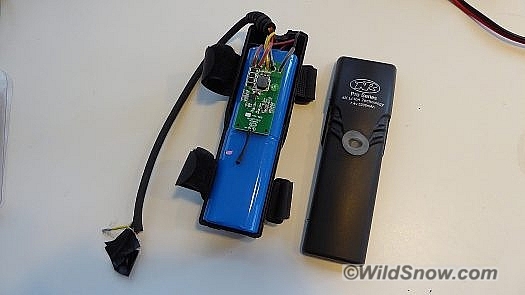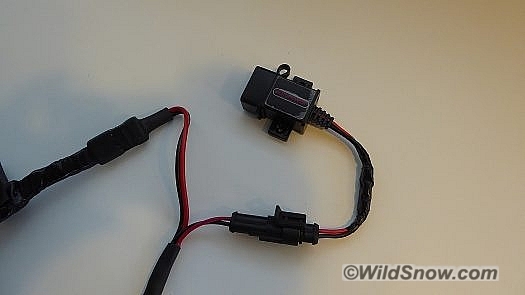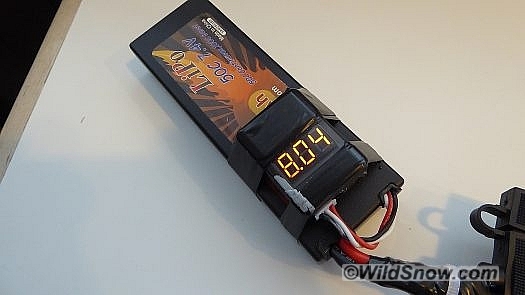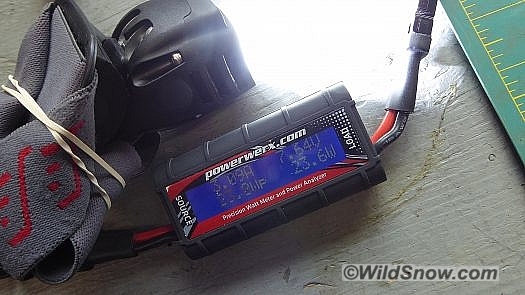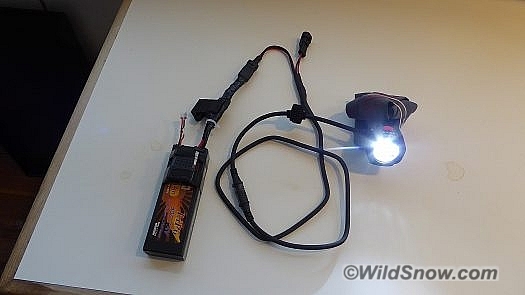
Modified with aftermarket LiPo battery and even a USB connector, Niterider shines again — and even charges a phone. (Note the voltage monitor, accessory connector and blade fuse holder.) Click images to enlarge.
Niterider headlamps such as their “Pro” models work well for nighttime backcountry skiing. They use powerful lithium-ion batteries that unfortunately do eventually fail. Purchasing OEM replacement batteries is an option, but they’re not cheap and you only get one. What is more, you’ll find quite a few Niterider batteries on Ebay, used, but who wants a used battery with unknown life? Rather than go that route I made a nearly direct replacement using a lithium-polymer “LiPo” battery sourced from the hobby market (as previously experimented with as power for the Arcteryx Voltair avalanche airbag backpack.) Wildsnow wrenching scale for this project, 3/10 provided you have some experience with electrical work. Most of the action is simple soldering and wire stripping.
(Note we also researched building a battery using lithium-ion, Li-ion, rather than lithium-polymer LiPo. See bottom of post for links, and stay tuned as we might do another build.)
Lisa’s expired battery Niterider model uses an external battery pack, conveniently printed with specifications of 7.4 volts, 5200 mAh. Easily sourced (see links below). Including charger and battery, this project ends up costing slightly less than simply buying a Niterider replacement, but adds a USB charging port as well as setting things up for as many additional batteries as you’d want. Or, you could build an enormous battery that’ll keep you illuminated for many hours.
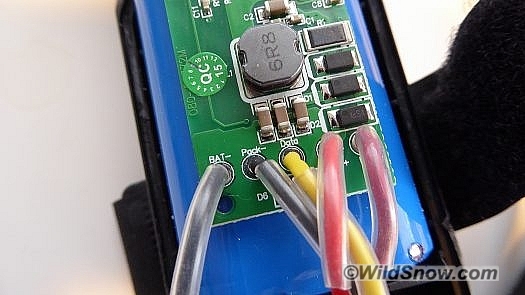
Wire connections are obvious as well. I eliminated the yellow “data” line and simply used the black as negative and red as positive. The new LiPo won’t fit in the original Niterider case, for our use that’s fine as we carry external headlamp batteries in the top flap of our backpacks. Note that with LiPo it’s important to use a “safety” case for both transport and charging — especially charging. These are simply heat resistant fabric envelopes, be sure to use one, and be sure to install a blade fuse holder near the battery (as shown in photos) as well as a low voltage alarm. A 5 amp fuse works fine for the Niterider and clearly provides good protection.
LiPo chargers vary quite a bit in price. We like the ones linked below as they come with a good variety of connectors and lots of charging options. If you’re careful with your shopping, you can probably find even lower prices. In terms of constructing, as simple alternative I could have wired the Niterider cable directly to the battery (including inline fuse on positive cable). I added a few optional connectors, mostly so I could easily swap to another battery.
If you wire directly to battery you’ll need to rig a Niterider type connector to the charger, but, DO NOT CHARGE WITH THE ORIGINAL NITERIDER CHARGER! You can probably salvage the connector from the Niterider charger, or Niterider cable extender. Just be extra careful with hooking everything up, especially your polarities. As for connectors in general, LiPo batteries come with various “plugs” for high current applications such as model car racing. Since the Niterider draws a max of 3 amps, no need to worry about your connectors so long as they’re insulated and secure. A good inexpensive option for these sorts of projects is the “flat” two pin automotive type connector you can pick up from Amazon or off the rack at the auto parts store. For example see this Amazon link. When using this sort of connector in this application, be sure the wire leads are of adequate thickness. I’d recommend #10 or #12 even though the actual Niterider lead appears to use #16 wire. Main reason for that is you want adequate wire for the charger current, as well as your primary battery wiring harness to always be at least a step thicker than accessory wires.
One of our comment contributor recommends the following charger, saves some coin and might be easier to use.
Lipo batteries vary in cost as well, I used one similar to the following, it seems to be fine and is contained in a hard plastic case, which in my opinion is essential for this type of application. Some LiPo batteries are sold without a case, they’re just thin plastic pouches, easily damaged. If you find a less expensive option be sure it’s still encased.
Common Sense RC Lectron Pro 7.4V 5200mAh 35C LiPo Battery Lithium Polymer
I used the USB converter-connector below, while sold for 12 volt systems it works fine supplied with the 7 or 8 volts from the LiPo.
MOTOPOWER 0609A 3.1Amp Waterproof Motorcycle USB Charger Kit SAE to USB Adapter
Lastly, draining your LiPo battery down to the dregs will damage or break it. To prevent, it’s necessary to run a low voltage monitor-alarm. I used the following, it connects to the battery “balance” connector that’s used when charging. Shows voltage as well as blaring a loud tone when you drop to target low. Link below also includes a “safety sack” you should use when carrying or charging any LiPo battery.
Bias Battery Safety Charge Sack and LiPo Battery Low Voltage Monitor Combo
LiPo batteries of the sort we used here do require attention in terms of safety. All batteries actually do, with perhaps LiPo needing a bit more TLC than normal. To that end, one could build a battery pack using lithium-ion batteries that are perhaps more consumer friendly. The following, for example, which including charger costs an easy half of the going price for used Niterider OEM 5200 mAh batteries. You’d need to wire two of the following batteries together (in parallel, for same 7.4 volts) to provide the continuous 3 amps current required by Niterider at full bright.
No matter what type of battery operated devices you use, it’s a good idea to study up on safety and use best practices, for example don’t charge any device near or in contact with flammable materials, and don’t leave any charger entirely unattended. That includes your phone. Google it. Most importantly, DO NOT DEEP DISCHARGE LIPO THEN ATTEMPT TO RECHARGE. Doing so can overheat the battery pack and start a fire. Minimum voltage is 3.0 volts per cell, which would be a total of 6 volts for the rig we built as the battery consists of 2 cells. Again, using a low voltage alarm and monitor is essential for this build, as well as paying attention to how much you’re using your lamp.
Tenergy 7.4V Li-ion 18650 2200mAh Rechargeable Battery Module with PCB
TLP-2000 Tenergy 0.5A Universal Smart Charger for Li-Ion/Polymer Battery Pack (3.7V-14.8V 1-4 cells)
WildSnow.com publisher emeritus and founder Lou (Louis Dawson) has a 50+ years career in climbing, backcountry skiing and ski mountaineering. He was the first person in history to ski down all 54 Colorado 14,000-foot peaks, has authored numerous books about about backcountry skiing, and has skied from the summit of Denali in Alaska, North America’s highest mountain.

